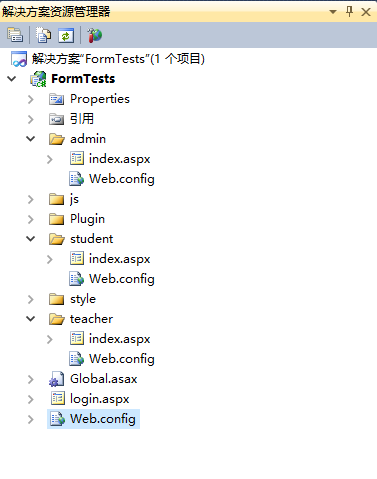Heim >Backend-Entwicklung >C#.Net-Tutorial >ASP.NET Forms-Authentifizierung
ASP.NET Forms-Authentifizierung
- 高洛峰Original
- 2017-02-10 17:09:061406Durchsuche
Im asp.net-Programm können Benutzer basierend auf ihren Rollen auf entsprechende Seiten und Funktionen zugreifen. In diesem Artikel wird dies vorgestellt, was einen sehr guten Referenzwert hat, um einen Blick auf die Entwicklung von
asp.net-Programmen zu werfen. Benutzer greifen auf entsprechende Seiten und Funktionen zu.
Die Projektstruktur ist wie folgt:

Stammverzeichnis Web.config-Code:
<?xml version="1.0" encoding="utf-8"?>
<!--
有关如何配置 ASP.NET 应用程序的详细消息,请访问
http://www.php.cn/
-->
<configuration>
<system.web>
<compilation debug="true" targetFramework="4.0" />
<authentication mode="Forms">
<forms loginUrl="login.aspx"></forms>
</authentication>
<!--<authorization>
<allow users="*"></allow>
</authorization>-->
</system.web>
</configuration>Web.config-Code im Admin-Ordner:
<?xml version="1.0"?> <configuration> <system.web> <authorization> <allow roles="admin" /> <deny users="*"/> </authorization> </system.web> </configuration>
Web.config-Code im Lehrerordner:
<?xml version="1.0"?> <configuration> <system.web> <authorization> <allow roles="teacher" /> <deny users="*"/> </authorization> </system.web> </configuration>
Web.config-Code im Studentenordner:
<?xml version="1.0"?> <configuration> <system.web> <authorization> <allow roles="student" /> <deny users="*"/> </authorization> </system.web> </configuration>
Cookie nach erfolgreicher Anmeldung in Login.aspx setzen, Cookie-Code setzen:
protected void SetLoginCookie(string username, string roles)
{
System.Web.Security.FormsAuthentication.SetAuthCookie(username, false);
System.Web.Security.FormsAuthenticationTicket ticket = new FormsAuthenticationTicket(1, username, DateTime.Now, DateTime.Now.AddDays(1), false, roles, "/");
string hashTicket = FormsAuthentication.Encrypt(ticket);
HttpCookie userCookie = new HttpCookie(FormsAuthentication.FormsCookieName, hashTicket);
HttpContext.Current.Response.SetCookie(userCookie);
}Authentifizierung in Global.asax:
protected void Application_AuthenticateRequest(object sender, EventArgs e)
{
HttpApplication app = (HttpApplication)sender;
HttpContext ctx = app.Context; //获取本次Http请求的HttpContext对象
if (ctx.User != null)
{
if (ctx.Request.IsAuthenticated == true) //验证过的一般用户才能进行角色验证
{
System.Web.Security.FormsIdentity fi = (System.Web.Security.FormsIdentity)ctx.User.Identity;
System.Web.Security.FormsAuthenticationTicket ticket = fi.Ticket; //取得身份验证票
string userData = ticket.UserData;//从UserData中恢复role信息
string[] roles = userData.Split(','); //将角色数据转成字符串数组,得到相关的角色信息
ctx.User = new System.Security.Principal.GenericPrincipal(fi, roles); //这样当前用户就拥有角色信息了
}
}
}Für weitere Artikel zur ASP.NET Forms-Identitätsauthentifizierung achten Sie bitte auf PHP Chinesische Website!
In Verbindung stehende Artikel
Mehr sehen- .Net Core-Grafikverifizierungscode
- Laden der .NET Core-Konfigurationsdatei und DI-Injektion von Konfigurationsdaten
- Dokumentation zum .NET Core CLI-Tool dotnet-publish
- asp.net verwendet .net-Steuerelemente, um Dropdown-Navigationsmenüs zu erstellen
- So erhalten Sie den Namen des Controllers in Asp.net MVC

